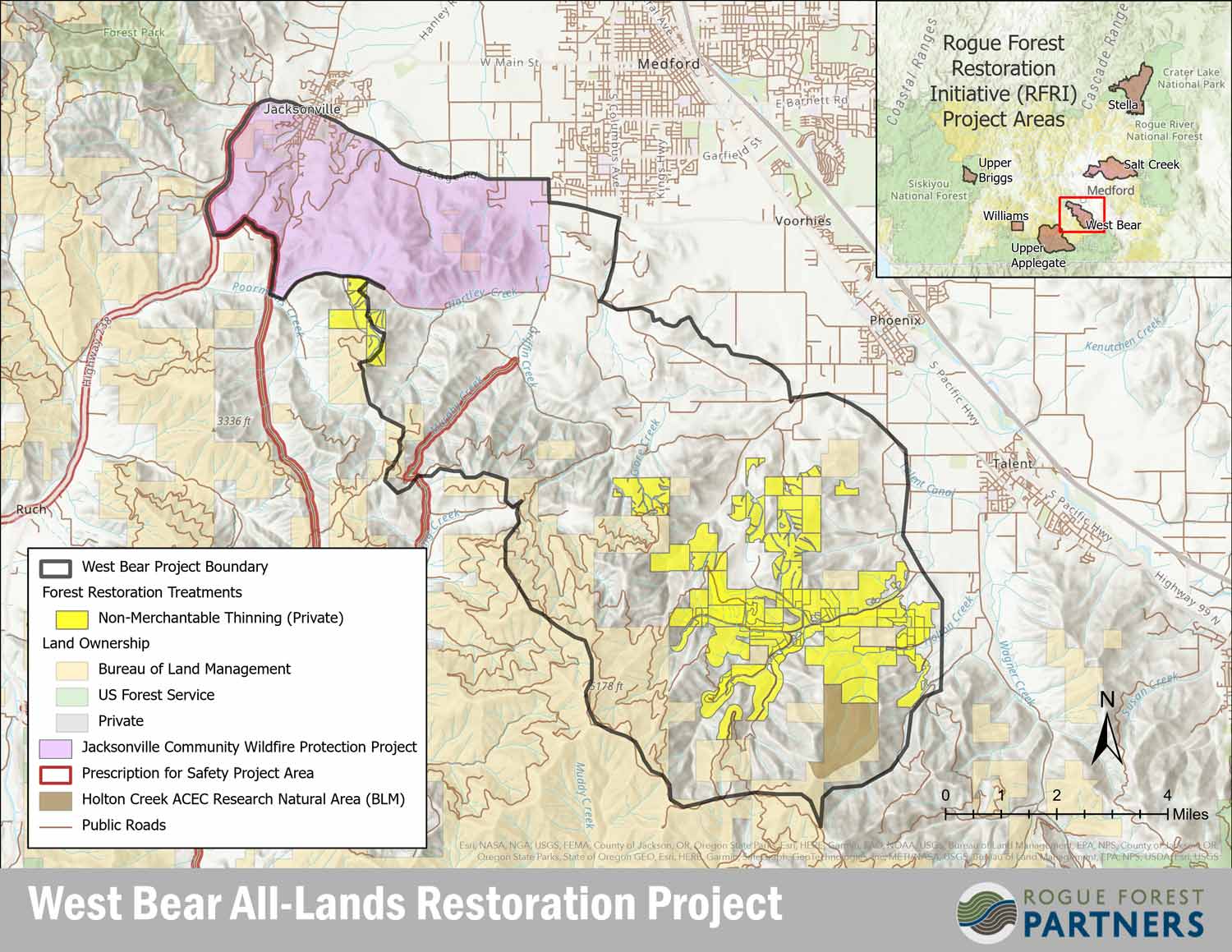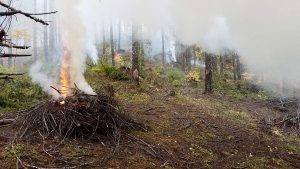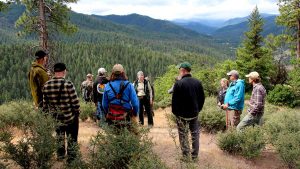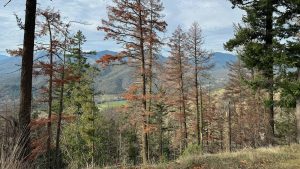West Bear Project Area
The West Bear All-Lands Restoration Project spans the wildland urban interface west of Bear Creek and the I-5 corridor from Talent to Jacksonville, Oregon. This 27,000-acre project area is one of the most at-risk locations for wildfire in Oregon, with seven of the top 30 most at-risk communities in the state and over 56,000 homes exposed to wildfire. The area’s fragmented ownership, susceptibility to wildfire, the concentration of homes, and economic significance require an immediate and coordinated all-lands stewardship approach.
The goal of the West Bear Project is to reduce wildfire risk to communities and the ecosystem to create a more resilient landscape through strategic ecological restoration and fuels management.
Where:
Jackson County, between Talent and Jacksonville, west of I-5
When:
Beginning in 2021, crews will begin restoration activity
Why:
Reduce the risk of wildfire and loss of homes through fuel reduction and education.
Scope:
10,800+ strategically targeted acres in a 27,000-acre footprint
By targeting specific sites for treatments, wildfire risk can be lowered by as much as 70% overall and a 50% reduction of risk to surrounding homes. Priority sites include areas around homes and roadsides, routes of ingress and egress, strategic ridgelines, and other regions to support safe evacuation and emergency response routes.
The West Bear Project also includes an education component to increase local community wildfire preparedness. It builds on the adjacent Ashland Forest Resiliency Stewardship Project, creating a contiguous landscape for strategic restoration treatments.
Healthier forests, healthier communities
Forest restoration is not only beneficial to the land, but it also benefits those who live and work in and around the area. Strategic forest treatments create healthier forests, more diverse wildlife, and reduce the risk to our homes and firefighters. Treatments can include fuel reduction and stand thinning, among other activities.
This project results from the collaboration between many partners, including local non-profit organizations, private landowners, state and federal agencies, Tribes, scientific experts, and community leaders. Partners have leveraged over $5 million of investment for West Bear Project treatments to date, including:
- NRCS Regional Conservation Partnership Program award to Lomakatsi for $2.6 million
- Sustainable Northwest SWIFT initiative private philanthropic investment of $2 million
- ODF E-Board award to Lomakatsi for $500,000
- FEMA Hazardous Fuels Mitigation Program grant through Oregon
- Office of Emergency Management to Lomakatsi for $479,000
- ODF Senate Bill 762.
Video Below: On March 9, 2022, the Rogue Forest Partners hosted an online community meeting to discuss the ongoing ecological thinning and prescribed fire taking place as part of the West Bear All-Lands Restoration Project.
RFP has identified six projects across the Rogue Basin. These high-priority areas, spanning public land and private tracts, are critically important for reducing the risks of extreme wildfires, promoting climate adaptation, and restoring resilience to our landscape. The work began in the Applegate and Illinois Valleys in 2020 and continues into 2025.
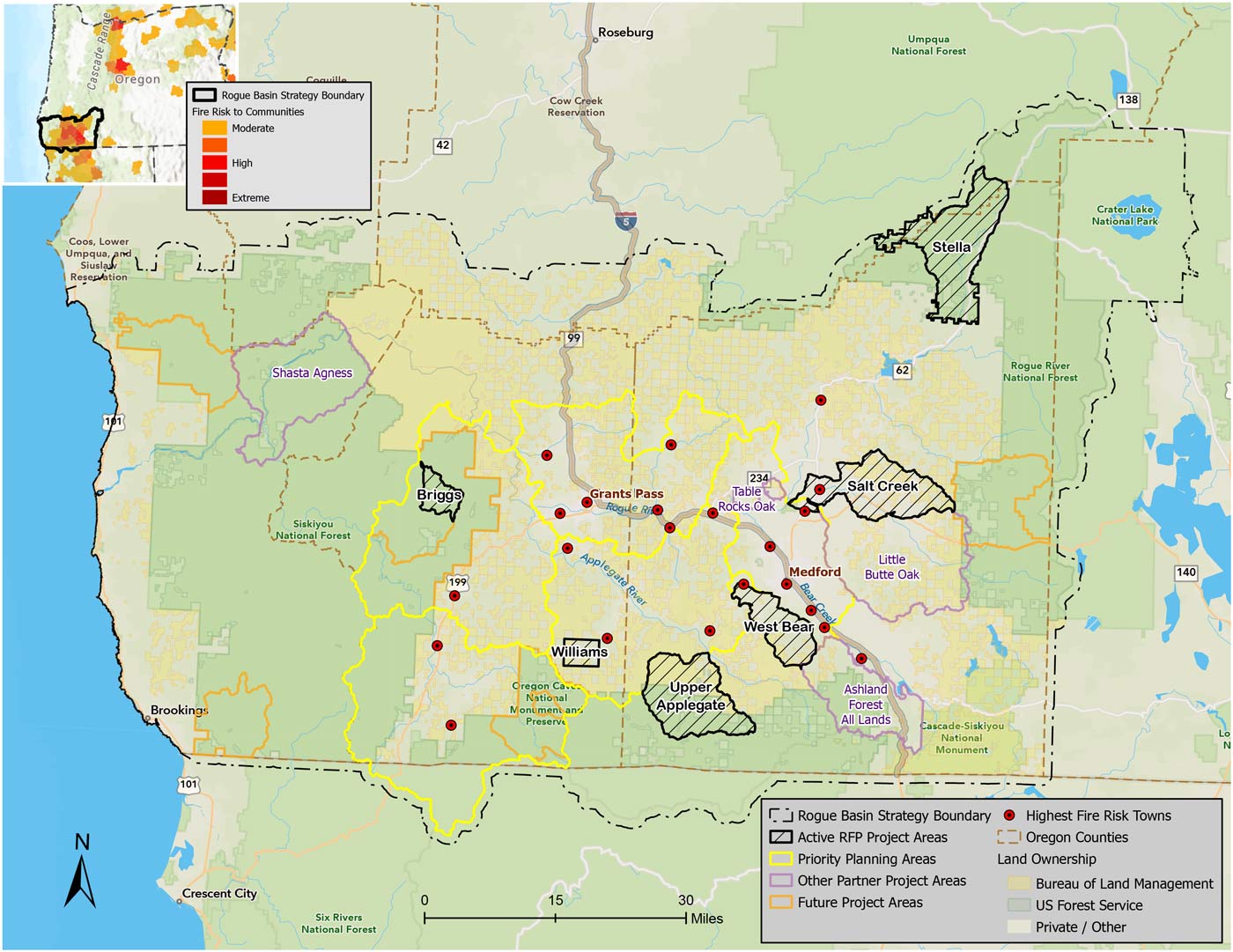
The Upper Briggs Restoration Project on the Wild Rivers District in the Illinois Valley supports diverse habitats and forest conditions. This ridge burned in the Klondike/Taylor fire, but from ridge to stream, one encounters legacy trees to protect, dense understories to be thinned and chaparral patches intermixed. The ridgeline is important for managing fires moving from wildlands toward Illinois Valley communities.
The Williams Project near the community of Williams in Josephine County is focused on reducing fuels and improving forest habitat through restoration treatments on federal and private lands in an all-lands effort bringing together the BLM and NRCS with the RFP to demonstrate restorative wildfire risk reduction. Together, we are working toward the landscape-vision of the RBS.
The West Bear Project addresses the need for wildfire fuels reduction immediately adjacent to the cities of Jacksonville, Phoenix, Talent, and Medford. The 27,000-acre project area within the wildland urban interface west of Bear Creek and the I-5 corridor is one of the most at-risk locations for wildfire in Oregon.
The 50,000-acre USFS and BLM Upper Applegate Watershed Project (UAW) is located in the Applegate Valley with over 18,000 acres of planned restoration treatments designed during a three-year community planning process convened by the Siskiyou Mountains Ranger District of the RRSNF. Some 3500 acres are scheduled by RFP to be completed by 2025. The UAW is one of the highest priority areas for restoration under the RBS.
The Stella Landscape Restoration Project project occurs in the most productive corner of the Rogue Basin, where the lack of low-intensity fire and past management has resulted in high-density stands and declining forest health. To improve wildlife habitat and forest health and build ecosystem resilience to wildfire, the Stella Project will strategically apply ecological thinning (both non-commercial and commercial) and prescribed fire to achieve restoration goals across a 43,955-acre footprint.
The Salt Creek Project planning area is large but RFP work with the BLM starts with a small footprint of fuels treatments in oak woodlands. The treatments will demonstrate ecological restoration under the RBS in these dry but diverse oak habitats and help reduce wildfire risks near the communities of Eagle Point.
The Rogue Basin communities, woodlands, and forests are at risk of uncharacteristic fire and no one organization can manage this risk. The Rogue Forest Partners share a common vision, seeking to restore forests and reduce risk by applying ecological restoration and bringing fire back as a tool.
Terry Fairbanks, Southern Oregon Forest Restoration Collaborative
News

